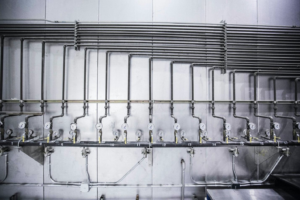A minor pipe leakage isn’t something to stress over. A small repair can fix the problem. But if your plumbing system has sustained damage in several parts, you might have to opt for repiping.
If you face recurring issues, such as discolored water, frequent leaks, low water pressure, etc., your plumbing lines are probably failing. Depending on the condition of the pipes, sections or the entire plumbing system may need to be replaced. But thinking about what might happen to your home during this process can be anxiety-evoking. Read on to discover what repiping your home can look like.
Repiping Your Home: What to Expect
Here’s what you can expect from the repiping process:
 A Professional Inspection
A Professional Inspection
Before the actual repiping, a team of professional plumbers will first inspect your home’s plumbing system to identify the root cause of the problem and determine whether you need sections or a full replacement.
Typically, whole-home repiping is recommended if substantial damage is identified. Opting for sectional replacement puts the old plumbing sections at risk of future damage, which may also add to your repair costs.
The Level of Demolition
One of the major things people are worried about during repiping projects is the level of demolition that occurs in their homes.
Experienced professionals won’t break down your entire home. They know how many walls or flooring to remove to access the plumbing system. However, every home is built differently, so the actual level of demolition will become known after a professional inspection.
One defining factor that does determine the extent of damage is the foundation of your home. You might be in luck if your home sits on a pier and beam foundation. Since the home has crawl spaces underneath, it allows plumbers to access your plumbing system easily. However, slab setups are much more complex and require extra work and demolition.
Choosing the Piping Material
During the repiping, you might want to change the piping material used in the plumbing lines, particularly if you opt to replace the entire plumbing system.
Most modern homes are switching to PEX piping as it costs significantly less and is highly durable. The second-best option is copper, as it is sturdy, UV-resistant, and prevents bacterial growth. However, it is pretty expensive.
Professional Repiping with Heartland Plumbing
An experienced plumber can help you choose the right plumbing system for repiping and ensure the job gets finished with minimal damage. Reach out to Heartland Plumbing to schedule an inspection. We guarantee 100% customer satisfaction!
Call us at (281) 789-4722 or drop an email at [email protected] to get more details.
